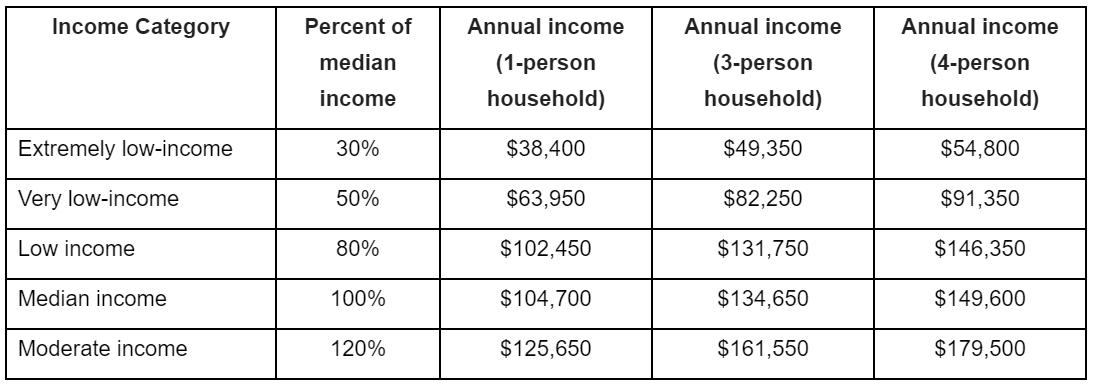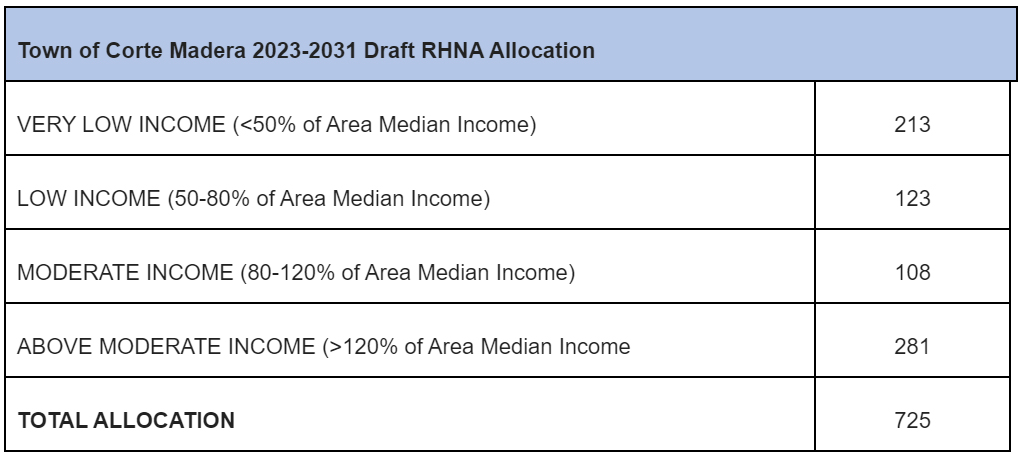
Timeline & FAQ
What is the Housing Element?
The Housing Element is a state-required policy document within the Corte Madera General Plan.
The Housing Element establishes housing related policies and programs addressing existing and projected future housing needs for all economic segments in the Town.
State law requires housing elements to be updated on a regular cycle.
Most cities and counties, including Corte Madera, are required to update their Housing Element every eight years.
This project will update the Housing Element for the period of 2023 to 2031.
The State also mandates that housing elements, unlike other elements of the general plan, be reviewed and certified by the State.
The foundation for the Housing Element is the Regional Housing Needs Assessment (RHNA), in which the State estimates each region’s housing needs for all income groups for the upcoming eight years.
The Town must identify enough potentially developable land zoned for residential use to meet the Town’s new RHNA housing capacity/production target.
The Housing Element provides goals, objectives, policies and programs to meet the housing needs of all Corte Madera’s citizens.
Key objectives of the Housing Element include accessibility to housing opportunities for all residents, promotion of fair and equal housing opportunities for all income levels and special-needs populations, and preservation of existing affordable housing in Town.
The Town started the Housing Element process in September 2021. The process is scheduled to last approximately 18 months and will be completed in 2023.
Timeline
Below is a conceptual timeline representing the overall process for the housing element update.
FAQ
The following is an ongoing list of Frequently Asked Questions (FAQ) that will be updated throughout the planning process.
Preguntas frecuentes
+ General
+ WHAT IS A HOUSING ELEMENT UPDATE AND WHAT ARE THE REQUIRED COMPONENTS?
The Housing Element is part of the Town’s General Plan, which sets forth guiding policies for future development. The requirement for each jurisdiction to adopt a General Plan is contained in state law which also lays out specific requirements for each element. The Housing Element provides an overarching statement of policies and programs to maintain and improve existing housing, and also accommodate a jurisdiction’s fair share of population growth needs. The Housing Element must be updated every eight years and it is the only element of the General Plan subject to certification by the California Department of Housing and Community Development (HCD).
The requirements in state law for Housing Elements include the following:
- Ensure adequate sites for new housing for persons of all income levels;
- Encourage and facilitate the development of affordable housing;
- Conserve and improve the existing affordable housing stock;
- Analyze and remove governmental constraints on new housing development;
- Promote equal housing opportunities;
- Preserve assisted housing; and
- Affirmatively further fair housing.
+ HOW LONG WILL IT TAKE TO PREPARE THE HOUSING ELEMENT UPDATE?
It will take approximately 18 months to prepare the Housing Element Update. Ultimately, a complete review and revision of the Housing Element will be developed and adopted by the Town Council by January 2023.
+ WHO IS PREPARING AND REVIEWING THE HOUSING ELEMENT UPDATE?
On September 21, 2021, the Town Council selected a housing consultant team, being led by O’Rourke & Associates, Lisa Wise Consulting (LWC) and Plan to Place, to assist the Town’s Planning Department with the preparation of the Housing Element Update. The Housing Element Update must be certified by the California Department of Housing and Community Development (CA HCD) by 2023.
+ WHAT ARE THE KEY STATE-MANDATED REQUIREMENTS FOR THE HOUSING ELEMENT?
The two key requirements under state law are 1) demonstrating that the Town can accommodate its assigned share of new housing need; and 2) ensuring that the Town’s zoning regulations comply with state laws regarding housing for persons with special needs.
+ Community Outreach
+ WHY IS IT IMPORTANT THAT I PARTICIPATE IN THE HOUSING ELEMENT 2031 UPDATE?
Your input will help shape Corte Madera housing for the next 8 years and ensure that policies and programs are inclusive and represent the values and ideas of the community. Your input will guide the development of key ideas, policies, and programs to ensure the future of affordable and accessible housing in Corte Madera.
+ HOW CAN I STAY INFORMED AND PROVIDE COMMENTS/FEEDBACK AS THE HOUSING ELEMENT UPDATE IS BEING PREPARED?
The Town is committed to community outreach and public engagement. This will be accomplished through a series of engagement opportunities that will include stakeholder/focus group check-ins, user surveys, and community workshops all tailored to meet current COVID-19 restrictions. All methods of outreach will be announced by email, listed on the project webpage, and provided through intermittent mailers throughout the life of the project. If you have questions or would like to comment on this process, please email: housingplan@tcmmail.org.
+ RHNA
+ HOW IS THE TOWN'S HOUSING NEED DETERMINED?
Prior to each planning “cycle”, the state determines how much new housing will be needed to accommodate projected population growth for different economic segments of the population. The total statewide housing need is then distributed to different regions according to their expected growth. Total housing need is based on the latest forecast of economic and demographic trends. The Association of Bay Area Governments (ABAG) then distributes a share to each local government in the nine Bay Area counties. Each jurisdiction is assigned a portion of the regional need at various income levels based on factors such as future population, access to jobs, and other factors. This assignment is known as the Regional Housing Needs Allocation (RHNA) and is intended to promote the following objectives:
- Increase the housing supply and the mix of housing types in an equitable manner
- Promote infill development that encourages alternatives to solo driving and reduces greenhouse gas emissions
- Balance jobs and housing
- Discourage housing development patterns that segment communities
- Affirmatively further fair housing
Each jurisdiction must ensure there is enough land with appropriate zoning to accommodate its RHNA allocation in its Housing Element.
+ WHAT IS "AFFORDABLE" HOUSING?
By definition, housing is considered “affordable” when total housing cost, including utilities, is no more than 30 percent of a family’s gross income, as shown in the table below. State law describes five income categories, which are based on a percentage of median county income, as shown in the following table. A variety of housing types is essential to provide housing options for individuals and families with lower and higher incomes, as well as to meet the needs of persons with disabilities. A mix of housing opportunities means, among other things that young adults moving into the housing market can stay in the cities they grew up in; workers like teachers, firefighters, health care workers and essential workers can find homes near their jobs; and older adults have more options for retirement and staying in their communities.

+ WHAT IS THE TOWN'S OBLIGATION REGARDING AFFORDABLE HOUSING?
State law requires cities to demonstrate that there are sufficient sites available that could accommodate the amount of new housing need identified in the RHNA. For the very-low- and low-income categories, zoning that allows a density of 20 units/acre or more is considered appropriate for affordable housing under state law.
+ WHEN LAND IS DESIGNATED TO ACCOMMODATE THE RHNA, IS THE JURISDICTION REQUIRED TO BUILD OR SUBSIDIZE AFFORDABLE HOUSING?
No. Jurisdictions are not required to subsidize housing or restrict properties for affordable housing. State law focuses on the availability of sites with appropriate zoning to accommodate affordable housing.
+ BUT AREN’T SUBSIDIES NECESSARY TO BUILD AFFORDABLE HOUSING?
Yes, significant subsidies are usually needed to make affordable housing economically feasible. It is important to note that state law does not require cities to build affordable housing – rather the law focuses on the things cities have control over, such as land use plans, zoning, and permit procedures. If the property owner is not interested in building affordable housing, the City may approve market-rate development as long as the project meets zoning standards.
+ WHAT IS THE RHNA ALLOCATION FOR THE 2023-2031 HOUSING ELEMENT PERIOD?
With a projected growth of over 441,000 households for the Bay Area by 2020, the Town of Corte Madera was assigned the housing need allocation shown below.

+ WHAT CAN HAPPEN IF CITIES DO NOT PROVIDE ZONING TO ACCOMMODATE THE RHNA?
Every city is required by law to accommodate its assigned share of new growth, including housing at affordable prices or rents. If a city does not adopt a Housing Element that demonstrates adequate sites to accommodate its RHNA, it could be subject to lawsuits and loss of its land use authority. The potential consequences that could result from a successful court challenge include court-ordered rezoning, court approval of high-density residential projects, or a moratorium on land use approvals or building permits until the Housing Element is brought into compliance with state law. Cities may also be ordered to pay substantial attorney fees to a successful party challenging the Housing Element.
+ Others
+ UPDATE TO THE SAFETY ELEMENT
There have been several recent updates to safety element requirements to include climate change vulnerability and adaptation and greater attention to wildfire and evacuation routes. Jurisdictions are required to complete a vulnerability assessment, develop adaptation and resilience goals, policies and objectives, and develop a set of feasible implementation measures addressing climate change adaptation and resiliency. Jurisdictions must review and update these portions of the safety element upon each revision of the housing element or local hazard mitigation plan (LHMP), but not less than once every 8 years. The Town of Corte Madera will be updating its Safety Element as part of the Housing Element Update.
+ WHAT IS AFFIRMATIVELY FURTHERING FAIR HOUSING?
Affirmatively furthering fair housing means taking meaningful actions, in addition to combating discrimination, that overcome patterns of segregation and foster inclusive communities free from barriers that restrict access to opportunity based on protected characteristics. Specifically, affirmatively furthering fair housing means taking meaningful actions that, taken together, address significant disparities in housing needs and in access to opportunity, replacing segregated living patterns with truly integrated and balanced living patterns, transforming racially and ethnically concentrated areas of poverty into areas of opportunity, and fostering and maintaining compliance with civil rights and fair housing laws.
+ HOW WILL THE TOWN ENSURE THAT HOUSING IN THE FLOODPLAIN IS PROTECTED FROM FLOODS AND SEA LEVEL RISE?
It is estimated that at least 600 units or 83% of the Town’s RHNA will be located in the FEMA 100-year flood zone where the parcels are relatively flat and larger, and where the majority of the Town’s commercial uses exist, allowing for potential residential redevelopment. The Town requires that all residential uses in the flood zone be raised 1-foot above base flood elevation. It is likely that any new residential units in the FEMA 100-year flood zone will be located above parking or ground floor commercial uses. In April 2021, the Town completed a Climate Adaptation Assessment to identify the Town’s vulnerabilities in the face of changing climatic conditions and to develop a roadmap for action based on a toolkit of potential options. The Town will continue to identify potential actions to mitigate some of the risks associated with sea level rise as part of the Climate Adaptation process.
If you have questions or comments, please email: housingplan@tcmmail.org.
